What are Varicose Veins?
Varicose veins are twisted, enlarged, or bulging veins that appear blue or purple. It is possible for any vein to become varicose, but the condition is typically seen in the veins of the legs and feet. Varicose veins are caused by faulty valves in the vein that cause the blood to flow improperly, either in the wrong direction or to pool instead of moving through the vein correctly.
Symptoms
Varicose veins are typically a self-diagnosable condition; however, if the condition is of a particular concern you may want to discuss the problem with your health care provider. Varicose vein symptoms include veins that appear to be blue or purple in color and swollen or gnarled in appearance. Non-cosmetic symptoms of varicose veins can involve a heavy, achy feeling in your legs, vein itching, bleeding from the varicose veins, burning, throbbing or cramping in your lower legs, pain after sitting or standing for long periods of time, and color changes in the veins or hardening of the veins.
Varicose Veins in Pregnancy
If you are suffering from varicose veins in pregnancy you are not alone. Many women are affected by varicose veins in pregnancy and there are a few possible culprits. Firstly, your blood volume increases when you are pregnant, however, the rate at which your blood flows from your legs to your pelvis decreases, putting pressure on the veins. A second possible reason you are experiencing varicose veins is the hormonal changes your body undergoes during pregnancy. Progestin levels increase during pregnancy, potentially dilating the veins. A third possible cause of varicose veins appearing during pregnancy is your growing uterus. As your pregnancy progresses and your uterus grows, pressure is put on your inferior vena cava, the largest vein in the body.
Prevention and Treatment
One of the best preventative measures you can take during your pregnancy is to exercise. During pregnancy you will want to speak to your doctor about safe exercise options for you. Additionally, you may want to avoid particular exercises known to exacerbate varicose veins such as intense running, weightlifting, squats, and lunges.
Additional natural prevention methods and treatment options for varicose veins in pregnancy include:
- Keep pregnancy weight gain to the healthy range suggested by your health care provider.
- Wear maternity support hose, which put pressure on your legs to stimulate blood flow. Avoid anything tight enough to cut off circulation.
- Eat a diet high in fiber and low in salt.
- Elevate your legs periodically.
- Do not sit or stand in the same position for long periods of time.
Medical treatment options for varicose veins include:
- A saline injection treatment called sclerotherapy can be done with little to no pain.
- Thermal ablation is a treatment that heats the vein to destroy it.
- Non-thermal ablation uses a potent drug to destroy the varicose veins.
While varicose veins can be an unsightly and even uncomfortable symptom of pregnancy for many women, taking the steps to prevent worsening symptoms will make the condition more manageable so you can focus on enjoying your pregnancy, not worrying about your veins.











